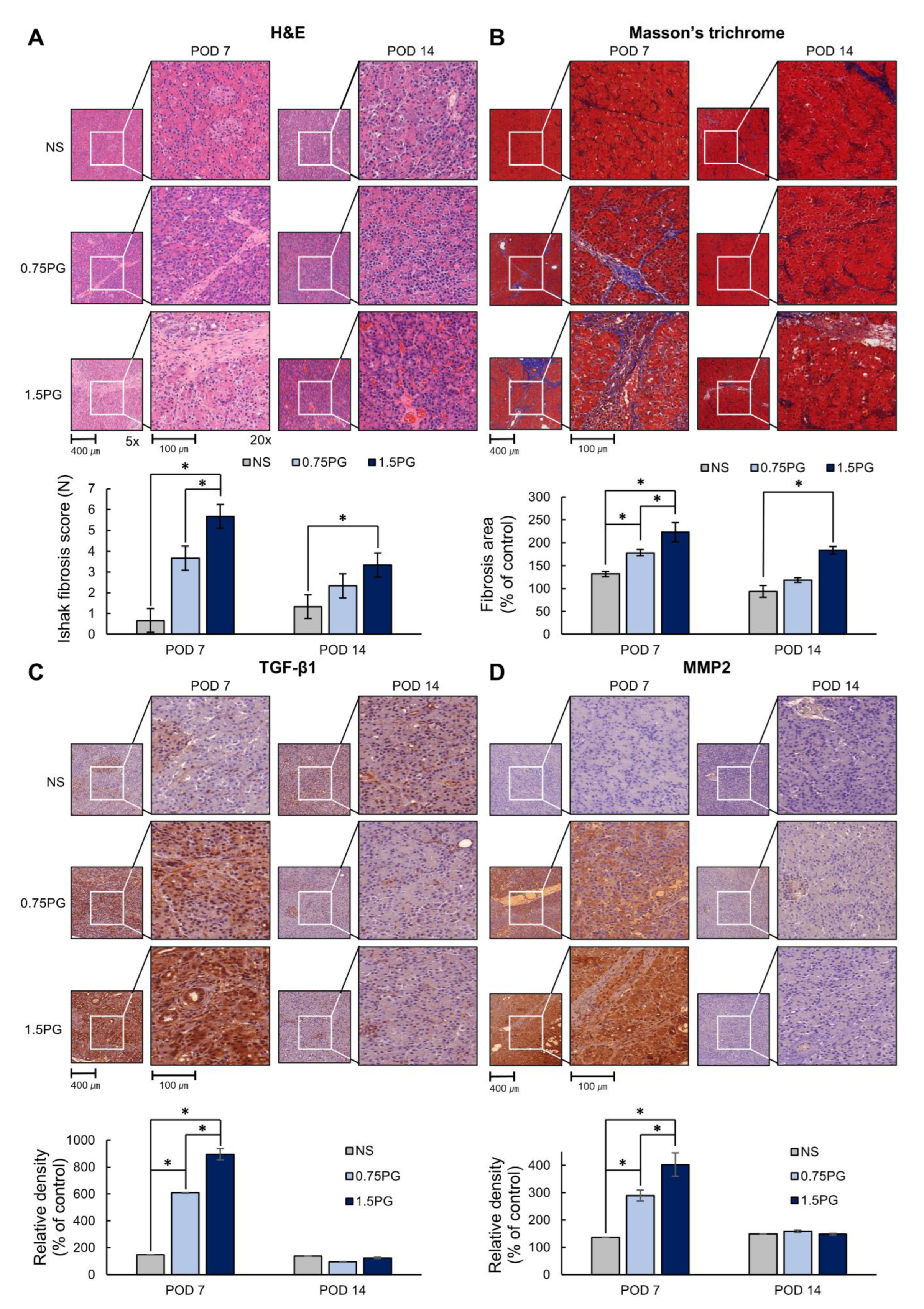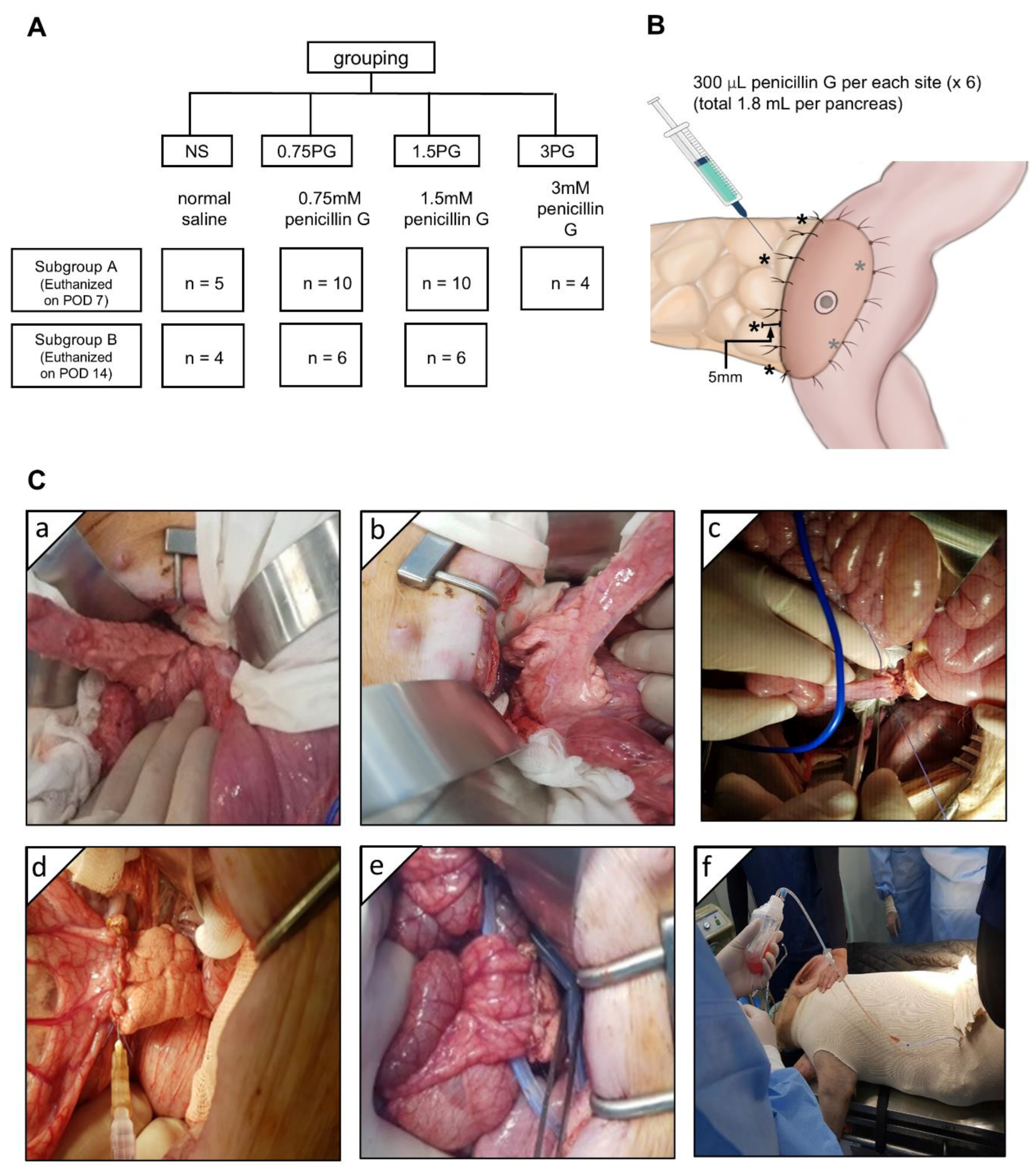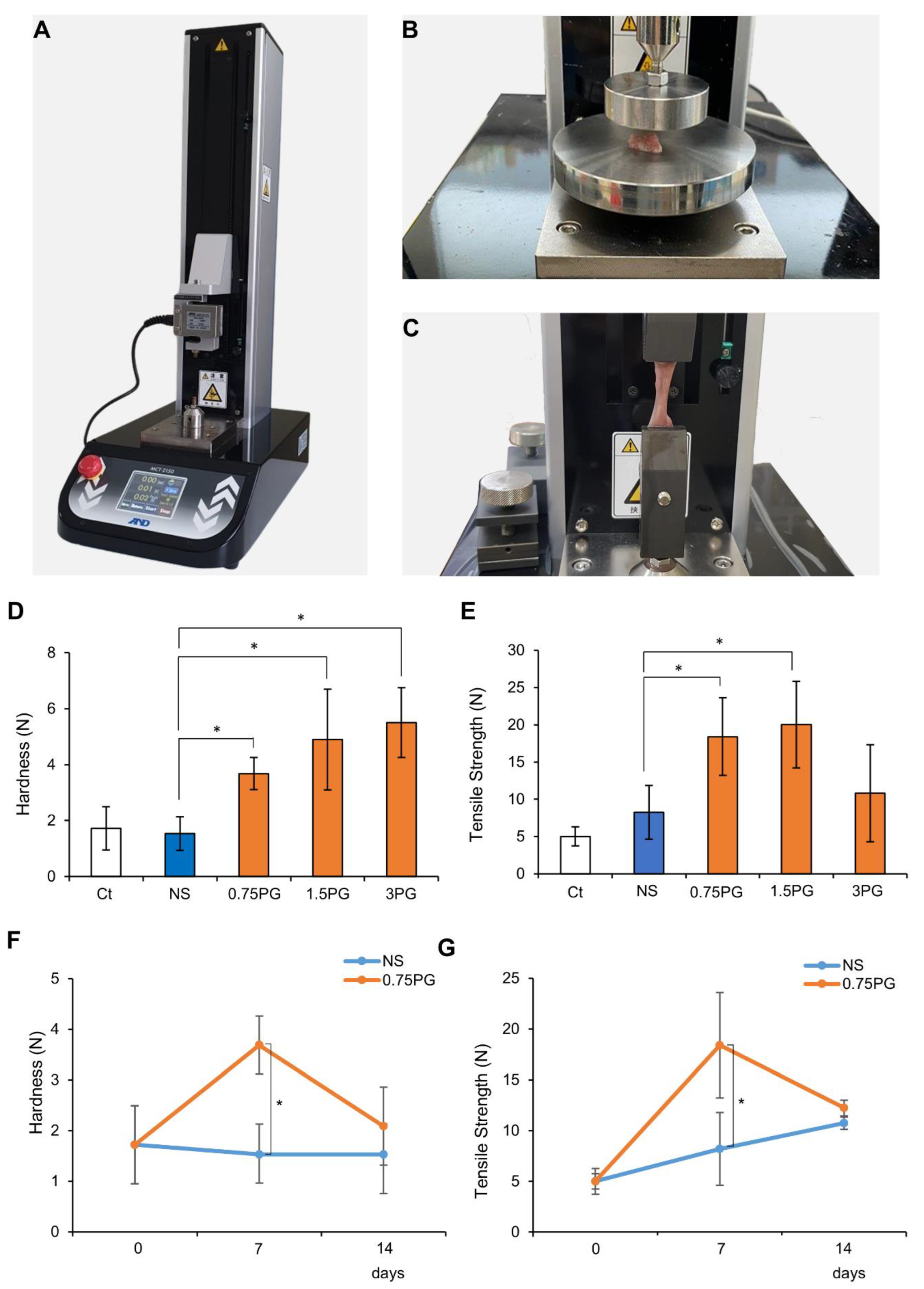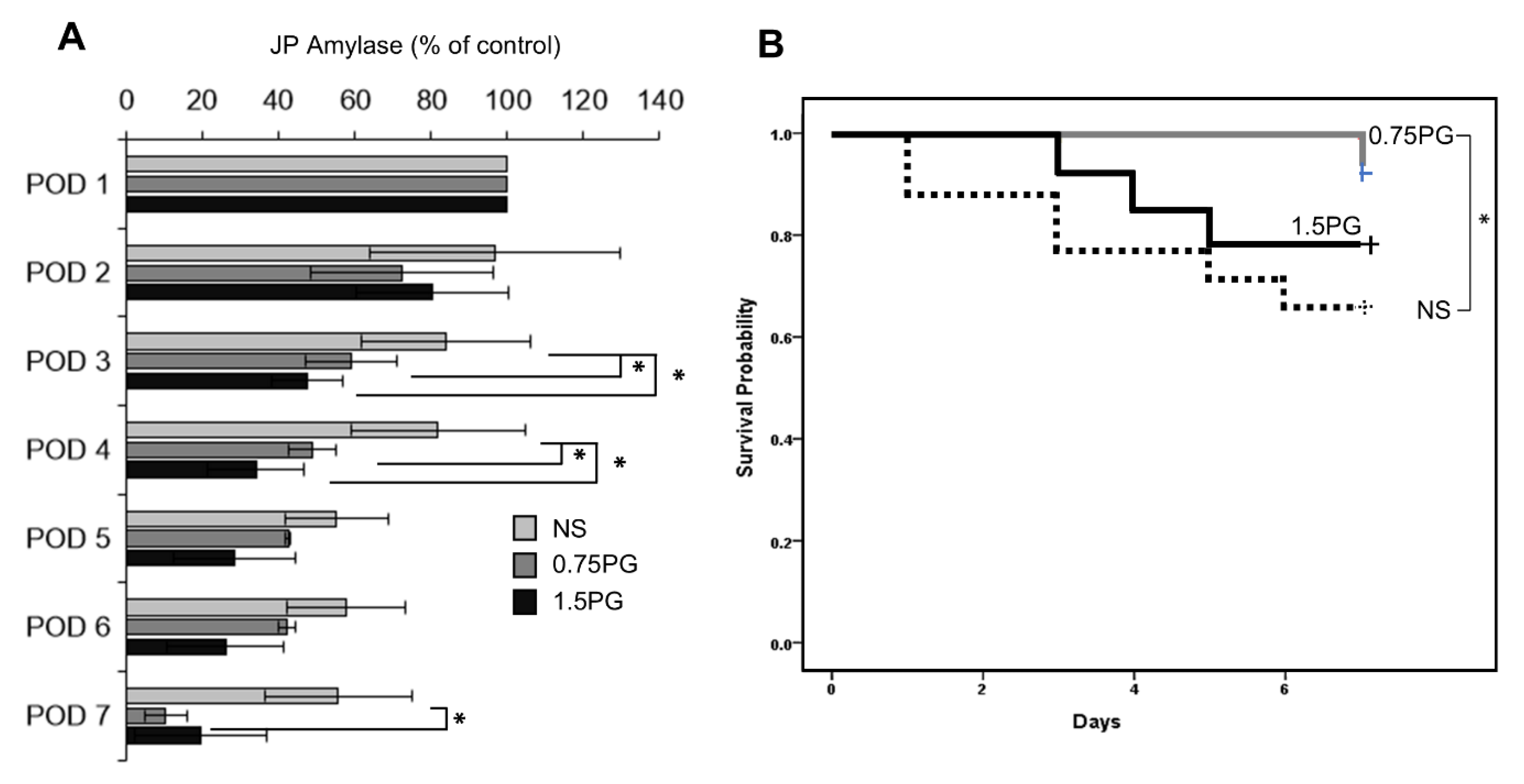Intraparenchymal Penicillin G Injection Promotes Wound Healing and Lowers POPF in Pigs After Pancreatic Surgery
Abstract
1. Introduction
2. Materials and Methods
2.1. Animals & Study Design
2.2. Measurement of Hardness and Tensile Strength of Pig Pancreas
2.3. Western Blotting Analysis
2.4. Masson’s Trichrome Staining and Immunohistochemistry
2.5. Enzyme-Linked Immunosorbent Assay (ELISA)
2.6. Statistical Analysis
3. Results
3.1. PG Effects on Pancreatic Hardness and Tensile Force
3.2. PG Effects on Pancreatic Fibrosis and Tissue Remodeling
3.3. PG Effects on Hepatic, Renal, Systemic Inflammatory, and Pancreatic Endocrine Function

3.4. PG Effects on the Development of POPF and Pig Survival
4. Discussion
5. Conclusions
Author Contributions
Funding
Institutional Review Board Statement
Informed Consent Statement
Data Availability Statement
Acknowledgments
Conflicts of Interest
References
- Bassi, C.; Buchler, M.W.; Fingerhut, A.; Sarr, M. Predictive factors for postoperative pancreatic fistula. Ann. Surg. 2015, 261, e99. [Google Scholar] [CrossRef]
- Bassi, C.; Dervenis, C.; Butturini, G.; Fingerhut, A.; Yeo, C.; Izbicki, J.; Neoptolemos, J.; Sarr, M.; Traverso, W.; Buchler, M.; et al. Postoperative pancreatic fistula: An international study group (ISGPF) definition. Surgery 2005, 138, 8–13. [Google Scholar] [CrossRef] [PubMed]
- Bassi, C.; Marchegiani, G.; Dervenis, C.; Sarr, M.; Abu Hilal, M.; Adham, M.; Allen, P.; Andersson, R.; Asbun, H.J.; Besselink, M.G.; et al. The 2016 update of the International Study Group (ISGPS) definition and grading of postoperative pancreatic fistula: 11 Years After. Surgery 2017, 161, 584–591. [Google Scholar] [CrossRef]
- Zhang, H.; Zhu, F.; Shen, M.; Tian, R.; Shi, C.J.; Wang, X.; Jiang, J.X.; Hu, J.; Wang, M.; Qin, R.Y. Systematic review and meta-analysis comparing three techniques for pancreatic remnant closure following distal pancreatectomy. Br. J. Surg. 2015, 102, 4–15. [Google Scholar] [CrossRef]
- Bassi, C.; Butturini, G.; Molinari, E.; Mascetta, G.; Salvia, R.; Falconi, M.; Gumbs, A.; Pederzoli, P. Pancreatic fistula rate after pancreatic resection. The importance of definitions. Dig. Surg. 2004, 21, 54–59. [Google Scholar] [CrossRef] [PubMed]
- Xiong, J.J.; Tan, C.L.; Szatmary, P.; Huang, W.; Ke, N.W.; Hu, W.M.; Nunes, Q.M.; Sutton, R.; Liu, X.B. Meta-analysis of pancreaticogastrostomy versus pancreaticojejunostomy after pancreaticoduodenectomy. Br. J. Surg. 2014, 101, 1196–1208. [Google Scholar] [CrossRef]
- Callery, M.P.; Pratt, W.B.; Vollmer, C.M., Jr. Prevention and management of pancreatic fistula. J. Gastrointest. Surg. 2009, 13, 163–173. [Google Scholar] [CrossRef] [PubMed]
- Swamy Gowda, N.N.; Obalanarasimhaiah, S.; Setty, B.N.; Jena, J.; Kumar, M.M. Postoperative day 3 drain amylase versus fistula risk score: Predicting clinically relevant postoperative pancreatic fistula following pancreatico-duodenectomy. Int. Surg. J. 2019, 7, 227. [Google Scholar] [CrossRef]
- Vallance, A.E.; Young, A.L.; Macutkiewicz, C.; Roberts, K.J.; Smith, A.M. Calculating the risk of a pancreatic fistula after a pancreaticoduodenectomy: A systematic review. HPB 2015, 17, 1040–1048. [Google Scholar] [CrossRef]
- Yeo, C.J.; Cameron, J.L.; Sohn, T.A.; Lillemoe, K.D.; Pitt, H.A.; Talamini, M.A.; Hruban, R.H.; Ord, S.E.; Sauter, P.K.; Coleman, J.; et al. Six hundred fifty consecutive pancreaticoduodenectomies in the 1990s: Pathology, complications, and outcomes. Ann. Surg. 1997, 226, 248–257, discussion 257–260. [Google Scholar] [CrossRef]
- Ma, L.W.; Dominguez-Rosado, I.; Gennarelli, R.L.; Bach, P.B.; Gonen, M.; D’Angelica, M.I.; DeMatteo, R.P.; Kingham, T.P.; Brennan, M.F.; Jarnagin, W.R.; et al. The Cost of Postoperative Pancreatic Fistula Versus the Cost of Pasireotide: Results from a Prospective Randomized Trial. Ann. Surg. 2017, 265, 11–16, discussion 257–260. [Google Scholar] [CrossRef]
- Weinberg, L.; Ratnasekara, V.; Tran, A.T.; Kaldas, P.; Neal-Williams, T.; D’Silva, M.R.; Hua, J.; Yip, S.; Lloyd-Donald, P.; Fletcher, L.; et al. The Association of Postoperative Complications and Hospital Costs Following Distal Pancreatectomy. Front. Surg. 2022, 9, 890518. [Google Scholar] [CrossRef]
- Williamsson, C.; Ansari, D.; Andersson, R.; Tingstedt, B. Postoperative pancreatic fistula-impact on outcome, hospital cost and effects of centralization. HPB 2017, 19, 436–442. [Google Scholar] [CrossRef] [PubMed]
- Çağrı Büyükkasap, A.; Dikmen, K.; Yavuz, A.; Altıner, S.; Göbüt, H.; Cihangir Emral, A.; Bostancı, H.; Kerem, M. Predictive value of drain fluid amylase level on postoperative day one after pancreatic resection for predicting postoperative pancreatic fistula. Turk. J. Surg. 2024, 40, 19–27. [Google Scholar] [CrossRef] [PubMed]
- Fukami, Y.; Saito, T.; Osawa, T.; Hanazawa, T.; Kurahashi, T.; Kurahashi, S.; Matsumura, T.; Komatsu, S.; Kaneko, K.; Sano, T. Which is the best predictor of clinically relevant pancreatic fistula after pancreatectomy: Drain fluid concentration or total amount of amylase? Ann. Gastroenterol. Surg. 2021, 5, 844–852. [Google Scholar] [CrossRef] [PubMed]
- Rykina-Tameeva, N.; Samra, J.S.; Sahni, S.; Mittal, A. Drain fluid biomarkers for prediction and diagnosis of clinically relevant postoperative pancreatic fistula: A narrative review. World J. Gastrointest. Surg. 2022, 14, 1089–1106. [Google Scholar] [CrossRef]
- Zhang, B.; Yuan, Q.; Li, S.; Xu, Z.; Chen, X.; Li, L.; Shang, D. Risk factors of clinically relevant postoperative pancreatic fistula after pancreaticoduodenectomy: A systematic review and meta-analysis. Medicine 2022, 101, e29757. [Google Scholar] [CrossRef]
- Schuh, F.; Mihaljevic, A.L.; Probst, P.; Trudeau, M.T.; Müller, P.C.; Marchegiani, G.; Besselink, M.G.; Uzunoglu, F.; Izbicki, J.R.; Falconi, M.; et al. A Simple Classification of Pancreatic Duct Size and Texture Predicts Postoperative Pancreatic Fistula: A classification of the International Study Group of Pancreatic Surgery. Ann. Surg. 2023, 277, e597–e608. [Google Scholar] [CrossRef]
- Adamu, M.; Plodeck, V.; Adam, C.; Roehnert, A.; Welsch, T.; Weitz, J.; Distler, M. Predicting postoperative pancreatic fistula in pancreatic head resections: Which score fits all? Langenbecks Arch. Surg. 2022, 407, 175–188. [Google Scholar] [CrossRef]
- Callery, M.P.; Pratt, W.B.; Kent, T.S.; Chaikof, E.L.; Vollmer, C.M. A Prospectively Validated Clinical Risk Score Accurately Predicts Pancreatic Fistula after Pancreatoduodenectomy. J. Am. Coll. Surg. 2013, 216, 1–14. [Google Scholar] [CrossRef]
- Ryu, Y.; Shin, S.H.; Park, D.J.; Kim, N.; Heo, J.S.; Choi, D.W.; Han, I.W. Validation of original and alternative fistula risk scores in postoperative pancreatic fistula. J. Hepato Biliary Pancreat. 2019, 26, 354–359. [Google Scholar] [CrossRef] [PubMed]
- Moriya, K.; Bae, E.; Honda, K.; Sakai, K.; Sakaguchi, T.; Tsujimoto, I.; Kamisoyama, H.; Keene, D.R.; Sasaki, T.; Sakai, T. A Fibronectin-Independent Mechanism of Collagen Fibrillogenesis in Adult Liver Remodeling. Gastroenterology 2011, 140, 1653–1663. [Google Scholar] [CrossRef] [PubMed]
- De Oliveira, R.C.; Wilson, S.E. Fibrocytes, Wound Healing, and Corneal Fibrosis. Investig. Ophthalmol. Vis. Sci. 2020, 61, 28. [Google Scholar] [CrossRef]
- Herrera, J.; Forster, C.; Pengo, T.; Montero, A.; Swift, J.; Schwartz, M.A.; Henke, C.A.; Bitterman, P.B. Registration of the extracellular matrix components constituting the fibroblastic focus in idiopathic pulmonary fibrosis. JCI Insight 2019, 4, e125185. [Google Scholar] [CrossRef]
- Kendall, R.T.; Feghali-Bostwick, C.A. Fibroblasts in fibrosis: Novel roles and mediators. Front. Pharmacol. 2014, 5, 123. [Google Scholar] [CrossRef]
- Lee, S.C.; Hong, T.H.; Kim, O.-H.; Cho, S.J.; Kim, K.-H.; Song, J.S.; Hwang, K.-S.; Jung, J.-K.; Hong, H.-E.; Seo, H.; et al. A Novel Way of Preventing Postoperative Pancreatic Fistula by Directly Injecting Profibrogenic Materials into the Pancreatic Parenchyma. Int. J. Mol. Sci. 2020, 21, 1759. [Google Scholar] [CrossRef] [PubMed]
- Adachi, E.; Harimoto, N.; Yamashita, Y.; Sakaguchi, Y.; Toh, Y.; Okamura, T.; Nishiyama, K.; Saeki, H.; Uchiyama, H.; Morita, M.; et al. Pancreatic leakage test in pancreaticoduodenectomy: Relation to degree of pancreatic fibrosis, pancreatic amylase level and pancreatic fistula. Hukuoka Acta Medica 2013, 104, 490–498. [Google Scholar]
- Belyaev, O.; Rosenkranz, S.; Munding, J.; Herzog, T.; Chromik, A.M.; Tannapfel, A.; Uhl, W. Quantitative assessment and determinants of suture-holding capacity of human pancreas. J. Surg. Res. 2013, 184, 807–812. [Google Scholar] [CrossRef]
- Eshmuminov, D.; Schneider, M.A.; Tschuor, C.; Raptis, D.A.; Kambakamba, P.; Muller, X.; Lesurtel, M.; Clavien, P.A. Systematic review and meta-analysis of postoperative pancreatic fistula rates using the updated 2016 International Study Group Pancreatic Fistula definition in patients undergoing pancreatic resection with soft and hard pancreatic texture. HPB 2018, 20, 992–1003. [Google Scholar] [CrossRef]
- Lee, S.E.; Jang, J.Y.; Lim, C.S.; Kang, M.J.; Kim, S.H.; Kim, M.A.; Kim, S.W. Measurement of pancreatic fat by magnetic resonance imaging: Predicting the occurrence of pancreatic fistula after pancreatoduodenectomy. Ann. Surg. 2010, 251, 932–936. [Google Scholar] [CrossRef]
- Koga, R.; Yamamoto, J.; Saiura, A.; Natori, T.; Katori, M.; Kokudo, N.; Makuuchi, M.; Yamaguchi, T. Clamp-crushing pancreas transection in pancreatoduodenectomy. Hepatogastroenterology 2009, 56, 89–93. [Google Scholar]
- Li, Y.; You, S.; Li, S.; Li, S.; Jia, A.; Xiang, X.; Shen, S.; Cai, Y. Exploration the therapeutic effects of sodium houttuyfonate combined with penicillin G on methicillin resistant staphylococcus aureus infected wounds. Front. Pharmacol. 2025, 16, 1530217. [Google Scholar] [CrossRef]
- Flores, M.J.; Brown, K.E.; Morshed, S.; Shearer, D.W. Evidence for Local Antibiotics in the Prevention of Infection in Orthopaedic Trauma. J. Clin. Med. 2022, 11, 7461. [Google Scholar] [CrossRef] [PubMed]
- Chaudhry, S.B.; Veve, M.P.; Wagner, J.L. Cephalosporins: A Focus on Side Chains and β-Lactam Cross-Reactivity. Pharmacy 2019, 7, 103. [Google Scholar] [CrossRef] [PubMed]
- Bootsma, B.T.; Plat, V.D.; van de Brug, T.; Huisman, D.E.; Botti, M.; van den Boezem, P.B.; Bonsing, B.A.; Bosscha, K.; Dejong, C.H.C.; Groot-Koerkamp, B.; et al. Somatostatin analogues for the prevention of pancreatic fistula after open pancreatoduodenectomy: A nationwide analysis. Pancreatology 2022, 22, 421–426. [Google Scholar] [CrossRef]
- Imamura, H.; Takahashi, H.; Akita, H.; Wada, H.; Mukai, Y.; Asukai, K.; Hasegawa, S.; Fujii, Y.; Sugase, T.; Yamamoto, M.; et al. The clinical impact of modified transpancreatic mattress sutures with polyglactin 910 woven mesh on postoperative pancreatic fistula in distal pancreatectomy. Surgery 2022, 172, 1220–1227. [Google Scholar] [CrossRef]
- Jang, J.Y.; Shin, Y.C.; Han, Y.; Park, J.S.; Han, H.S.; Hwang, H.K.; Yoon, D.S.; Kim, J.K.; Yoon, Y.S.; Hwang, D.W.; et al. Effect of Polyglycolic Acid Mesh for Prevention of Pancreatic Fistula Following Distal Pancreatectomy: A Randomized Clinical Trial. JAMA Surg. 2017, 152, 150–155. [Google Scholar] [CrossRef]






Disclaimer/Publisher’s Note: The statements, opinions and data contained in all publications are solely those of the individual author(s) and contributor(s) and not of MDPI and/or the editor(s). MDPI and/or the editor(s) disclaim responsibility for any injury to people or property resulting from any ideas, methods, instructions or products referred to in the content. |
© 2025 by the authors. Licensee MDPI, Basel, Switzerland. This article is an open access article distributed under the terms and conditions of the Creative Commons Attribution (CC BY) license (https://creativecommons.org/licenses/by/4.0/).
Share and Cite
Park, J.H.; Han, J.H.; Lee, D.; Kim, K.-H.; Hong, T.H.; Kim, O.-H.; Jeon, S.-J.; Choi, H.J.; Kim, S.-J. Intraparenchymal Penicillin G Injection Promotes Wound Healing and Lowers POPF in Pigs After Pancreatic Surgery. Biomedicines 2025, 13, 650. https://doi.org/10.3390/biomedicines13030650
Park JH, Han JH, Lee D, Kim K-H, Hong TH, Kim O-H, Jeon S-J, Choi HJ, Kim S-J. Intraparenchymal Penicillin G Injection Promotes Wound Healing and Lowers POPF in Pigs After Pancreatic Surgery. Biomedicines. 2025; 13(3):650. https://doi.org/10.3390/biomedicines13030650
Chicago/Turabian StylePark, Jung Hyun, Jae Hyun Han, Dosang Lee, Kee-Hwan Kim, Tae Ho Hong, Ok-Hee Kim, Sang-Jin Jeon, Ho Joong Choi, and Say-June Kim. 2025. "Intraparenchymal Penicillin G Injection Promotes Wound Healing and Lowers POPF in Pigs After Pancreatic Surgery" Biomedicines 13, no. 3: 650. https://doi.org/10.3390/biomedicines13030650
APA StylePark, J. H., Han, J. H., Lee, D., Kim, K.-H., Hong, T. H., Kim, O.-H., Jeon, S.-J., Choi, H. J., & Kim, S.-J. (2025). Intraparenchymal Penicillin G Injection Promotes Wound Healing and Lowers POPF in Pigs After Pancreatic Surgery. Biomedicines, 13(3), 650. https://doi.org/10.3390/biomedicines13030650




